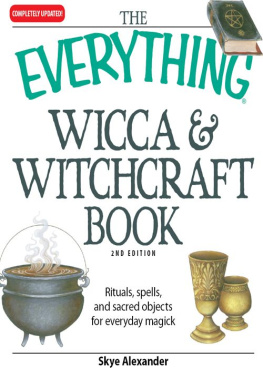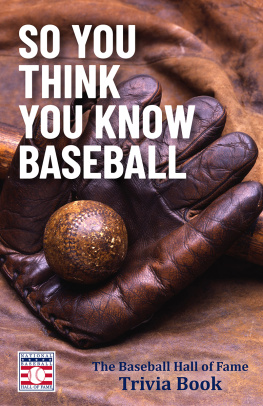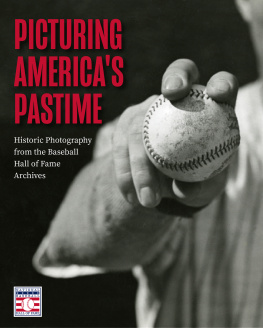
The author and publisher have provided this e-book to you for your personal use only. You may not make this e-book publicly available in any way. Copyright infringement is against the law. If you believe the copy of this e-book you are reading infringes on the authors copyright, please notify the publisher at: us.macmillanusa.com/piracy.
Contents
Preface
Ive undertaken to write neither an anecdotal history of baseball, la books by such authors as Joseph Durso, Douglas Wallop, and Harvey Frommer, nor anything so detailed as David Voights and Harold Seymours multivolume histories. There are anecdotes; there is detail. Ive sought, though, to maintain a balance in that regard, as well as in more general matters of explanation and interpretation. I wanted to cover the history of baseballas game, sport, business, and social institutionin a way that would interest baseball-lovers of all kinds, be sound enough to satisfy specialists, and prove serviceable as a compact, inclusive one-volume history.
Ive subtitled this book An American Baseball History, at least in part to forewarn readers that it contains virtually nothing about the rich baseball history of Japan. And while baseball in Canada, the Caribbean, and Central America receives some attention, the focus is on the origins, development, and significance of baseball within the United States. If I havent been able to explain whyas Jacques Barzun wrote many years ago, whoever would know the mind and heart of America had better learn baseballI at least hope that whoever finishes this book will have come to realize that baseball history reveals much about life in this country over the past century and a half.
My treatment is chronological, because history pretty much happens that way, not topically or thematically. It seems to me that, as far as possible, history ought to be narrated in real time, which means giving some sense of the crowded, disordered nature of the past. Thus Ive integrated a number of different themes and topics into a chronological frame extending from roughly the 18301840s up to the 1990 baseball season.
* * *
Much of what I know about events in baseball history over the past forty-five years comes from personal observation and recollectionin other words, from being a fan. Two good personal and professional friendsWarren F. Kimball, of the graduate faculty in history, Rutgers University, and Eugene C. Murdock, of the emeritus faculty, Marietta Collegehave also been devoted followers of the game since childhood. Once again they were willing to give my work a close, critical, and corrective reading, bringing to bear their strong knowledge of both baseball and U.S. history. Its always a pleasure to thank them for letting me impose on their time, expertise, and good natures.
I also appreciate the interest and indulgence of upwards of one thousand students whove taken my American Baseball History course since I started offering it at Ohio University in 1985. This book strongly reflects the way my thinking has developed as Ive taught that course year by year.
And, as always, I owe thanks to JoAnn Erwin Alexanderfor nearly everything. But then, after thirty years, she already knows that.
C.C.A.
ATHENS, OHIO
August 1990
I see great things in baseball;
its our game,
the American game.
Walt Whitman
1. The New York Game
Within less than three years, the people of the United States would be locked in an epochal civil conflict that would kill more of them than any other war in their historypast or future. But on Tuesday, July 20, 1858, for the couple of thousand Americans who paid a stiff fifty cents each to get into the Fashion Race Course near the village of Flushing on Long Island, and then jammed the little grandstand and elbowed each other around the track railing, the most important thing about to happen was a game of baseball.
One team, representing the city of New York and consisting of players drawn from baseball clubs in Hoboken, New Jersey; Morrisania (just north of the Harlem River in the Bronx); and the Gothams, Empires, and Eagles from Manhattan itself, would meet an all-star outfit made up of players from the Putnam, Excelsior, Atlantic, and Eckford clubs in the independent city of Brooklyn. It was the first match in what was planned as a three-game series, bringing together most of the best players in the country.
Early in the afternoon, spectators began reaching the site by horseback, carriage, and the special trains run for the occasion by the little Flushing Rail Road. Others walked as many as five miles. The players arrived with their full club memberships in horse-drawn omni-buses decorated with flags, bunting, and streamers; the Excelsiors came by the Fulton Avenue Line in a huge conveyance pulled by fourteen gray horses bedecked in feathered bridles.
The interclub Committee of Management, having prohibited the sale of anything stronger than beer, was delighted with the very decorous conduct of the immense numbers on the ground. The presence of a couple of hundred well-dressed ladies supposedly added to the wholesomeness of the event.
At 2:30 the game started on the grass diamond laid out inside the racetrack. Batting first, the Brooklyns scored three runs. They added two more in the second inning, while the New Yorks counted once. Each team scored twice in the third inning; then New York made four runs in the fourth to tie the game at 77. Brooklyn came back with four in the fifth inning, only to see New York rally for seven scores in its turn at bat. Each club tallied two more runs in the sixth inning and one in the seventh. Brooklyn scored four times in the eighth, but the New Yorks piled up five more. Although the outcome was decided when the Brooklyn players failed to score in the top half of the ninth inning, they courteously took the field so their opponents could have an equal number of times at bat. The New Yorks also made their three outs without scoring, so that the final count was New York 22, Brooklyn 18.
After cheering each other on the field, the players adjourned to the little clubhouse atop the racecourse grandstand to exchange champagne toasts and raise their glasses to the Niagara Club, several of whose members had traveled all the way from Buffalo to watch the event. The president of the Excelsiors hoped for a better outcome in the return match the following month.
Reporters from several Manhattan newspapers as well as the Brooklyn Daily Eagle covered the game. Frank Pigeon of the Brooklyns won praise for his play in the short field (shortstop), as did Harry Wright in center field for New York. Outfielders Green and OBrien of Brooklyn had excelled particularly in catching the ball on the fly, while New Yorks Davis made a miss on a ball, which, if he had held it, would have immortalized him as a fielder. The only moment of controversy had come late in the game, when Wadsworth of New York swung at the ball and somehow managed to hit it off his forefinger. The Brooklyn pitcher tossed over to first, but the umpire, seated under an umbrella at a table about twenty feet from the home base, had ruled no play.
All in all, thought the New York Times, it had been a fine match, one that would be long remembered with pleasure by all lovers of this noble and invigorating game. Indeed it had been the most-talked-about and watched baseball event up to that timesomething of a landmark in the evolution of the New York game from a pleasant recreational activity, based on the ancient English childrens game of rounders, into a mature competitive sport.



















